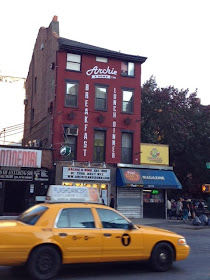Whenever I'm walking through Brooklyn Heights, there are certain buildings and dwelling of such reliable charm, beauty and interest that I invariably stop when I pass them and take a good long gander.
The simple white, two-and-a-half story number at the northeast corner of Hicks and Cranberry—No. 59 Hicks Street—is such a house. It's not the most impressive structure in the area. But in its modest, village-like qualities, it is somehow very Brooklyn Heights-ish. It looks like it should be in some small town in Massachusetts, not in the middle of a huge metropolis. It is also evidently a very old structure, even to the untrained eye.
For years, this was the home of the Heights Veterinary Hospital. And, as far as I can tell, that's what it was for a long time. Here's a photo of the same building from 1958, when it was already the a hospital for animals. Not only that, it was white, just as it is today. In fact, nothing about the facades seems to have altered in the last 50 years.
The address has a very distinguished history. It was built by a cooper named John Rogers in 1822. Rogers apparently fell on hard times, for in 1846 the household furniture was put up for auction.
Its greatest fame came later, when it was the office of none other than John and Washington Roebling, the designers of the Brooklyn Bridge. A building can't get more Brooklyn than that without being the one-time home of Walt Whitman.
The Roeblings were out by 1897, when the house was advertised as renting for $35 a month. In 1911, the trustees of Plymouth Church bought the property, with the intent of using it as an entrance to the nearby church. They purchased it from Rev. Dr. Frank Halliday, who was for many years the assistant to Rev. Henry Ward Beecher, when the latter was pastor at Plymouth.
At some point after that, a chain grocery store operated out of the space. In 1937, a poor, hungry man named Anthony Gimenez was arrested for stealing eight loaves of bread (value: 64 cents) from the store. It was next owned by Joe Kaplan, who repaired and altered Navy uniforms for seaman down at the Navy Yard.
It's life as a veterinary hospital began in 1957 when Dr. Bernard Wasserman bought and renovated the building. Dr. Richard Turoff worked with Dr. Wasserman for four-and-a-half years before buying the practice in 1985. (Dr. Wasserman, who continued to live above the clinic with his wife Bernice, died in November 2012. Dr. Turoff closed the hospital closed in 2012. Turoff, who was reported to be an old-fashioned type doc and didn't charge a lot, decided to retire last year.
It's life as a veterinary hospital began in 1957 when Dr. Bernard Wasserman bought and renovated the building. Dr. Richard Turoff worked with Dr. Wasserman for four-and-a-half years before buying the practice in 1985. (Dr. Wasserman, who continued to live above the clinic with his wife Bernice, died in November 2012. Dr. Turoff closed the hospital closed in 2012. Turoff, who was reported to be an old-fashioned type doc and didn't charge a lot, decided to retire last year.
















